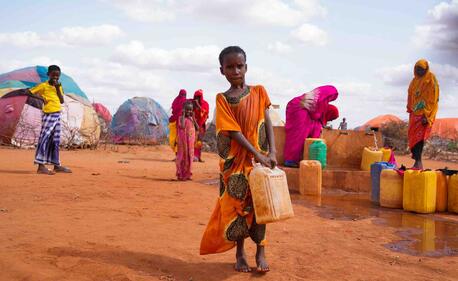
UNICEF Report: Children Displaced in a Changing Climate: Preparing for a Future Already Underway
Weather-related events, exacerbated by climate change, are driving millions of children from home. Yet lack of data has hampered efforts to identify and help those most at risk. Until now.
Summary
All children have a right to grow up in a safe and secure home. Yet, today, far too many children are denied that right. Floods, storms, droughts and wildfires are increasingly severe and prolonged due to climate change, forcing millions of children to flee home.
The new UNICEF report, "Children Displaced in a Changing Climate," links weather-related disasters to 43 million children displaced over the last six years. Floods and storms drove 95 percent.
Fast-moving storms or rapidly spreading wildfires suddenly wrenching children from home are traumatic. But knowing it's only a matter of time before home is unlivable can be just as bad for children in places where climate shocks grow more severe.
In the Horn of Africa, years of back-to-back failed rainy seasons have created one of the worst emergencies of the past four decades. The scale of the displacement is immense – and growing rapidly.
But, because families’ decisions to leave home aren’t always linked to a specific event, drought displacement is difficult to track. Decisions to move can occur over time as livelihoods erode, communities shrink and hope dwindles, exerting untold pressures on children.
Abdurazak Mohammed, a sixth grader from the Somali region of Ethiopia, watched as people abandoned his community.
“Many families sent their children with their cattle," says Abdurazak. "The teachers also left. Then the school is closed. I feel sad to see my school closed.”
The violent storms and flooding that cause displacement can be deadly for those who can't leave in time. But journeys during chaotic mass evacuations and accommodations in overcrowded temporary shelters can be just as perilous.
Children can become separated from their parents or caregivers, exposing them to the risk of trafficking, violence, abuse and exploitation.
Families on the move often struggle to access medical care and other essentials children need to stay healthy, like vaccines.
Easily accessible safe water and adequate sanitation can also be hard to come by, making children susceptible to disease and malnutrition.
When an evacuation site's location lies in the path of violent storms or flooding, children displaced by extreme weather can easily conclude nowhere is safe.
Despite all these risks, insufficient data on the number of children displaced has made them virtually invisible. Children moving through areas impacted by climate shocks and other stressors like rapid urbanization and conflict often slip through the cracks.
To identify those most at risk, UNICEF worked with the Internal Displacement Monitoring Center (IDMC) and the Patrick J. McGovern Foundation to analyze historical data on children displaced by extreme weather. Those findings are now helping to identify where children are most likely to be uprooted next.
Among the key findings:
- The Philippines, India and China account for the most significant number of children displaced by extreme weather: 22.6 million. Yet, Small Island Developing States (SIDS) and countries in the Horn of Africa are the most affected.
- Displacement due to slow-onset disasters like droughts is likely radically underreported.
- Wildfires affect low- and high-income countries alike.
- Children and their communities are most vulnerable in countries where disaster risk is high but coping capacities are limited, like Haiti and Mozambique.
- Over the next three decades, flooding of rivers will displace far more children than cyclone winds and storm surges.
- By sheer numbers, South Asia will see the greatest number of children displaced over the next 30 years, followed by East Asia and the Pacific. Yet, the risk for children in Latin America and the Caribbean is greater.